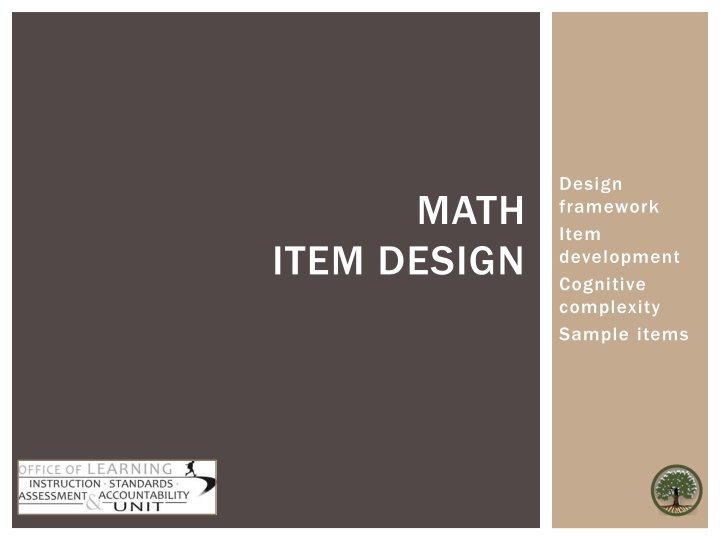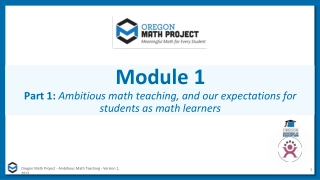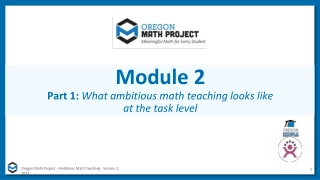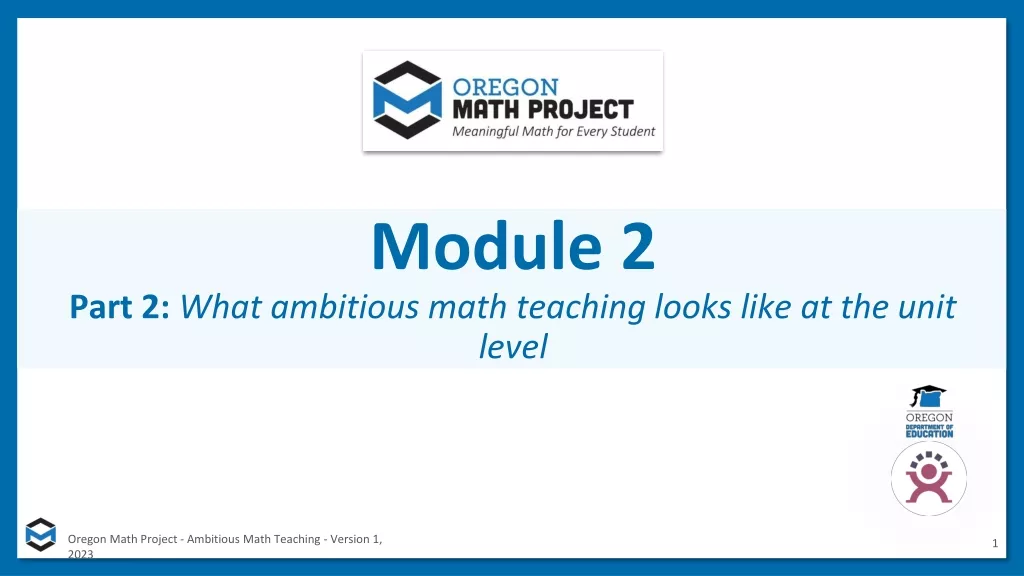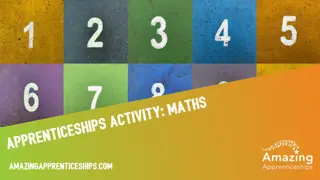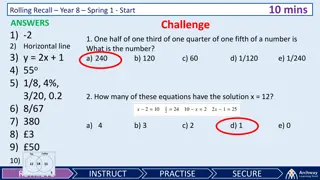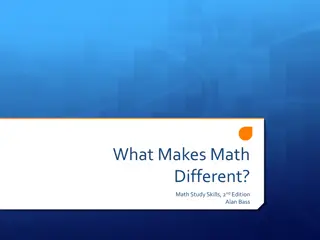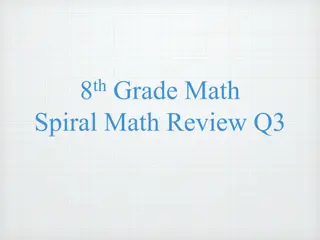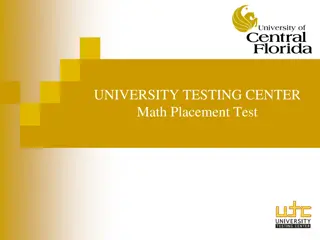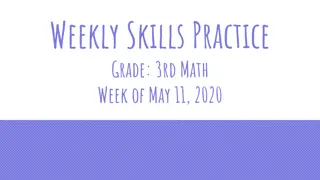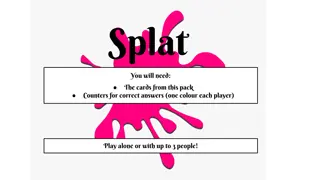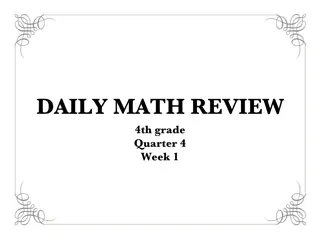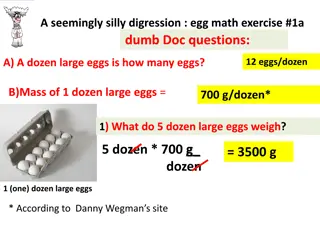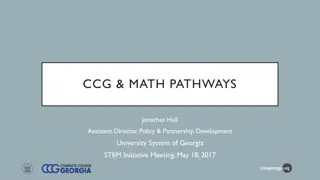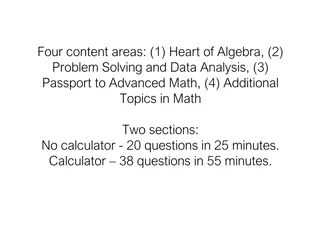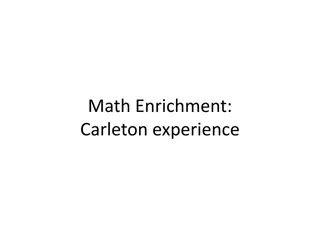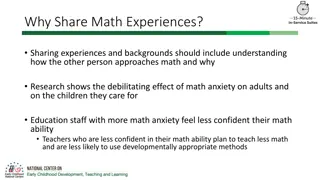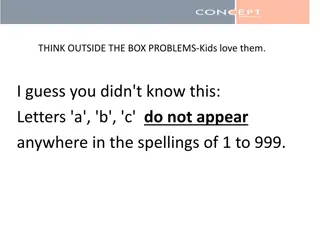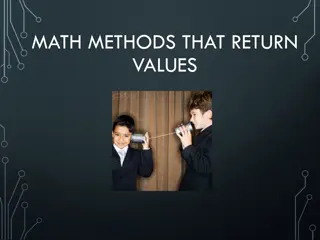MATH
Explore frameworks for developing cognitive complexity in math items, aligning teaching with assessments, and ensuring fairness and grade appropriateness in item development. Learn about building blocks for learning progression and criteria for alignment degree determination
Download Presentation

Please find below an Image/Link to download the presentation.
The content on the website is provided AS IS for your information and personal use only. It may not be sold, licensed, or shared on other websites without obtaining consent from the author.If you encounter any issues during the download, it is possible that the publisher has removed the file from their server.
You are allowed to download the files provided on this website for personal or commercial use, subject to the condition that they are used lawfully. All files are the property of their respective owners.
The content on the website is provided AS IS for your information and personal use only. It may not be sold, licensed, or shared on other websites without obtaining consent from the author.
E N D
Presentation Transcript
Design framework Item development Cognitive complexity Sample items MATH ITEM DESIGN
4 BUILDING BLOCKS Learning Progression Item Design Assessment Quality Outcomes/ Scoring
ITEM DESIGN FRAMEWORK BEAR Assessment System Step 2 A match between what is taught and what is assessed Constructive alignment aligning teaching and assessment to the learning outcomes/standards (Biggs, 2003) Proposed items are located along the LP map One Framework (Wilson & Sloane, 2000) Learning Outcomes/ Standards Assessment Task Teaching & Instruction
ALIGNMENT FRAMEWORK Item design framework used by Smarter-Balanced Assessment under the evidence-centered design approach (Mislevy, Steinberg, & Almond, 2003) Defined as the degree to which expectations and assessments work together to improve and measure students learning
4 CRITERIA TO DETERMINE THE DEGREE OF ALIGNMENT 1. Categorical concurrence Commonality between the content categories of the standards and those of the assessment items 2. Range of knowledge correspondence Number of objectives within each standard covered by item(s) 3. Balance of representation Relative coverage of content categories by items in a test 4. Depth of Knowledge consistency Match between the cognitive demand of items and the level of cognitive demand communicated by the wording of the objectives
ITEM DEVELOPMENT Universal design Design item that accurately assess the targeted competency for all students Ensure item fairness make sure that items are equally difficult for groups of equal ability (e.g. males and females; urban and rural) Vocabulary & language use content-specific language appropriate to the assessed grade For non-content-specific material, use vocabulary/language from previous grade levels
ITEM DEVELOPMENT Grade appropriateness Design items that assess a primary content domain/standard of the appropriate grade For non-reading items, the reading level is approximately one grade level below the grade level of the test, except for specifically assessed content terms or concepts (SBAC, 2012) Using items to link tests For pre-post test designs, include some items that appeared on previous test(s) to measure student progress If the time between tests is relatively long (i.e. 2-3 months), the same test can be used If the time is short (i.e. 2-3 weeks), pick a few items to reuse and include new ones
COGNITIVE COMPLEXITY Use of Modified Bloom s Taxonomy Definition An example of Cognitive Rigor Matrix (Hess, et al., 2009) Demonstration on how to align standards and proposed item(s) on the LP map
MODIFIED BLOOMS TAXONOMY Modified by Anderson & Krathwohl (2001) Evaluation Synthesis Analysis Application Comprehension Knowledge Old Bloom s Taxonomy (Bloom, 1956)
SAMPLE ITEMS FOCUS ON APPLICATION PROCESS Process Process Level 1: Recall Level 1: Recall & Reproduction & Reproduction Level Level 2: Skills & 2: Skills & Concepts Concepts Level 3: Level 3: Strategic Strategic Thinking/ Thinking/ Reasonin Reasoning g Level 4: Level 4: Extended Extended Thinking Thinking Apply: Carry out or use a procedure in a given situations; carry out (apply to a familiar task) or use (apply) to an unfamiliar task. Follow simple/routine procedures. Apply an algorithm or formula. Solve routine problems applying multiple concepts or decision points. Use or apply concepts to solve non-routine problems. Select or devise an approach among many alternatives to solve a novel problem.
SAMPLE ITEM* Intended level: Grade 8 Domain: Expressions and Equations Content standard: Analyze and solve linear equations and pairs of simultaneous linear equations. CCSS: Analyze and solve pairs of simultaneous linear equations (8.EE.8). Intended claims: 1, 2 2, 3 and 4 Max is organizing a trip to the airport for a party of 75 people. He can use two types of taxi. A small taxi costs $40 for the trip and holds up to 4 people. A large taxi costs $63 for the trip and holds up to 7 people. * Adapted from SBAC (2013, p. 134)
SAMPLE ITEM GRADE 8 How many taxis of each type should Max order, to keep the total cost as low as possible? Explain. LP level LP level Specific Standard Specific Standard Cognitive Rigor Cognitive Rigor Analyze and solve linear equations and pairs of simultaneous linear equations. Analyze and solve pairs of simultaneous linear equations (8.EE.8). Apply, Level 3 (Strategic Thinking/reasoning)
SAMPLE ITEM GRADE 7 Let L be the number of large taxis needed and S be the number of small taxis needed. a. Write an expression to show the number of taxis needed. b. If Max orders 6 large taxis, how many small taxis will he need? b. How much will the cost be? LP level LP level Specific Standard Specific Standard Cognitive Cognitive Rigor Rigor Solve real-life and mathematical problems using numerical and algebraic expressions and equations. Use variables to represent quantities in a real-world or mathematical problem, and construct simple equations and inequalities to solve problems by reasoning about the quantities. (7.EE.4). Apply, Level 2 (Skills & Concepts
SAMPLE ITEM GRADE 6 a. Let x be the number of large taxis needed. If Max wants to order large taxis only, evaluate x. b. If each person must equally share the cost of taking large taxi defined previously, write an expression for the cost of each person. Let y be the amount of money each person must pay. Calculate y. LP level LP level Specific Standard Specific Standard Cognitive Cognitive Rigor Rigor Apply and extend previous understandings of arithmetic to algebraic expressions. Write, read, and evaluate expressions in which letters stand for numbers. (6.EE.2). Apply, Level 1 (Recall and Reproduction)
BIBLIOGRAPHY Bloom, B. S. (1956). Taxonomy of educational objectives. Handbook I: The Cognitive Domain. New York, NY: David McKay Co. Anderson, L. W., & Krathwohl, D. (2001). A Taxonomy for Learning, Teaching, and Assessing: A Revision of Bloom's Taxonomy of Educational Objectives. New York, NY: Longman. Hess, K., Carloc, D., Jones, B., & Walkup, J., (2009). What exactly do fewer, clearer, and higher standards really look like in the classroom? Using a cognitive rigor matrix to analyze curriculum, plan lessons, and implement assessments. Paper presented at CCSSO, Detroit, Michigan. Nitko, A. J., & Brookhart, S. (2007). Educational assessment of students. Upper Saddle River, NJ: Pearson Education, Inc. McMillan, J. H. (2007). Classroom assessment. Principles and practice for effective standard-based instruction (4th ed.). Boston: Pearson - Allyn & Bacon. Oregon Department of Education. (2014, June). Assessment guidance. Webb, N. (2007). Aligning assessments and standards. Retrieved from http://www.wcer.wisc.edu/news/coverStories/aligning_assessments_and_standards.php Wilson, M. (2005). Constructing measures: An item response modeling approach. New York, NY: Psychology Press, Taylor & Francis Group. Wilson, M., & Sloane, K. (2000). From principles to practice: An embedded assessment system. Applied Measurement in Education, 13 (2), pp. 181-208. Smarter Balanced Assessment Consortium. (2012, April). General item specifications. Smarter Balanced Assessment Consortium. (2013, June). Content specifications for the summative assessment of the Common Core State Standards for Mathematics. Revised draft.
CREATIVE COMMONS LICENSE Item Design (Math) PPT by the Oregon Department of Education and Berkeley Evaluation and Assessment Research Center is licensed under a CC BY 4.0. You are free to: You are free to: Share Share copy and redistribute the material in any medium or format Adapt Adapt remix, transform, and build upon the material Under the following terms: Under the following terms: Attribution Attribution You must give appropriate credit, provide a link to the license, and indicate if changes were made. You may do so in any reasonable manner, but not in any way that suggests the licensor endorses you or your use. NonCommercial NonCommercial You may not use the material for commercial purposes. ShareAlike ShareAlike If you remix, transform, or build upon the material, you must distribute your contributions under the same license as the original. Oregon Department of Education welcomes editing of these resources and would greatly appreciate being able to learn from the changes made. To share an edited version of this resource, please contact Cristen McLean, cristen.mclean@state.or.us.
